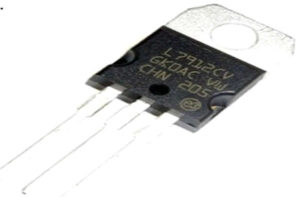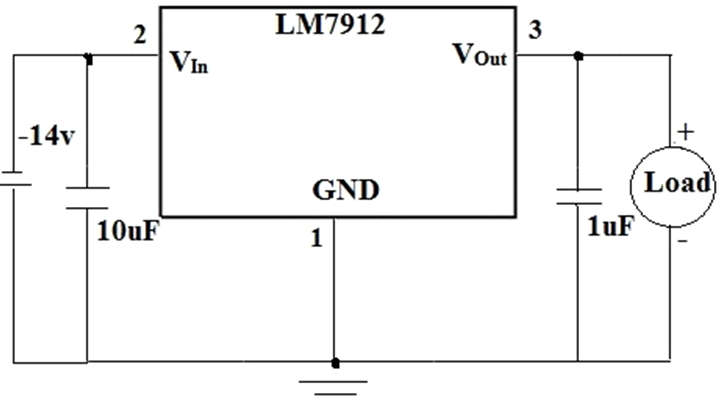- We employ both positive and negative voltages in all of the circuits for our applications because they are both necessary. Negative voltages are typically not employed with these devices; instead, positive voltages and ground are used. Negative voltages are those that are lower than the voltage at the ground. By switching the polarity, the power supply can operate these. If negative voltages are not steady, they can potentially harm the circuit. Negative voltage regulators are used to stabilize them and draw a steady negative output voltage. The LM7912 is one of these regulators that is offered on the market.
What is LM7912?
- Typically, a support voltage of -5V is utilized from the transformer-based power supply to supply negative voltages to the circuit, such as -3.3V. However, these voltages cannot be reliably regulated.
- However, they introduce noise and disruption to the output voltage. Positive voltage regulators might be utilized for this purpose. Additionally, the circuit will use a resistive divider based on -5V rather than 0V to control the output voltage. The regulator’s accuracy suffers as a result.
- Voltage regulators are necessary to produce stable output even with fluctuating input. These circuits often include a differential amplifier that compares input and output voltages. A reference voltage equating to the output voltage is supplied to this.
- A regulator’s dropout value is the smallest voltage difference between the output and reference voltages that can be recognized by the differential amplifier and controlled by the regulator.
- The regulator’s input voltage must be greater than the sum of its output voltage and dropout value for it to function. If the requirements for the input voltage are not met, the regulator merely functions as a resistive circuit in which the input and output are equal.
- A negative voltage regulator used to control negative voltages is the LM7912. These were created specifically to control negative voltages. These have the best power supply rejection ratio and the least amount of noise. The LM7912’s output voltage is -12V.
Pin Configuration
- The regulator series of LM79xx comes in a TO-220 power package. The device contains three terminals. They are Input, Output, and Ground. This device gives an output current of 1.5A. LM7912 is available with fixed voltages such as -5V, -12V, -15V.

- The ground terminal is used to provide common ground to both input and output terminals. This pin is connected to the ground. To the input terminal, the unregulated voltage is applied. The regulated output is drawn from the output terminal.
Circuit Diagram of LM7912 and How To Use It
- As it is a negative voltage regulator the power source applied or the input applied to the circuit should be negative. So, the polarity of the input is reversed in the circuit. LM7912 works with the input voltages in the range of -14V to -27V.

- At the input and output terminals, capacitors are utilized to filter out signal noise. Additionally, these circuits contain a thermal overload prevention device to guard against damage brought on by high power dissipation.
- Internal short circuit protection is present to restrict the circuit’s maximum current. The output current drops as the voltage across the pass transistor rises. Output transistor safe area compensation is offered to make up for this loss.
Where to Use LM7912?
- A negative voltage regulator IC is the LM7912. This circuit is utilized in situations where the application of negative voltages is necessary. For instance, at sensors, in analog circuitry, etc.
- Because this IC is available in several fixed voltage configurations, including -5V, -12V, and -15V, these are selected depending on the needs of the application. This IC’s output current is 1A, but it may deliver up to 2.2A if a suitable heat sink is used.
Specifications of LM7912
The specifications of LM7912 include the following.
- LM7912 is a 12V negative voltage regulator.
- It has a minimum voltage input of -14.5 V.
- The maximum voltage input of LM7912 is -27 V.
- It works with a peak output current of 2.2 A.
- The average output current of LM7912 is 1 A.
- It has an internal thermal overload and short circuit current limiting protection.
- LM7912 is available in the TO-220 package only.
- Bypass capacitors are necessary for stable operation.
- Output bypass capacitor improves the transient response of the regulator.
- If aluminum electrolytes are used for bypass capacitors, their value should be 10μF or larger.
- Operating junction temperature range is 00c to +1250c.
- The storage temperature range is -650C TO +1500C.
- Lead temperature is 2300C.
- High Ripple rejection.
Applications of LM7912
The applications of LM7912 include the following.
- It can be used in analog and digital circuits as power or reference voltage.
- This IC can be used as a current limiter in various applications.
- LM7912 has a dual supply.
- It also has an output polarity-reversal-protection circuit.
- High stability 1A regulator.
- As a current source.
- Light Controller using silicon photocell.
- High-sensitivity light controller.
- Dual trimmed supply.
Equivalent Voltage Regulator IC
- The equivalent voltage regulators which have similar functionality to LM7912 are LM7905, LM7915, and LM7918. Here the value 79 indicates that it is a negative voltage regulator. The next two digits after 79 give the output voltage values provided by the regulators.
- LM7905 gives the output of -05V. LM7915 indicates that the regulator produces the output of -15V and LM7918 gives the output of -18V.
- Usually, negative references are required using devices such as sensors. Different methods such as using a Zener diode to generate negative references are used. This is an easy solution but, when the power from the transformer is used for references it is bound to have noise and fluctuations in voltages. So, negative voltage regulators are very useful in such situations. Further electrical characteristics can be found in the LM7912 datasheet.
